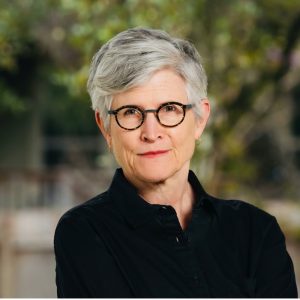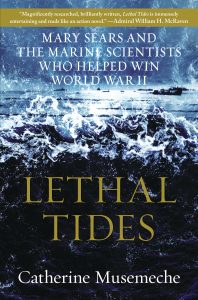Talking About Women’s History: Three Questions and an Answer with Dr. Catherine Musemeche
Catherine “Kate” Musemeche is a graduate of the University of Texas McGovern Medical School in Houston, Texas and the University of Texas School of Law. Musemeche’s first book, Small, was longlisted for the E.O. Wilson/Pen American Literary Science Award and was awarded the Texas Writer’s League Discovery Prize for Nonfiction in 2015. Her second book, Hurt, was named one of the top ten EMS books of the decade. She has also contributed to Smithsonian Magazine, the Wall Street Journal, New York Times’ “Motherlode” blog, KevinMD.com, Creative Nonfiction magazine and EMS World. She lives in Austin, Texas.
In her most recent book, Lethal Tides: Mary Sears and the Marine Scientists Who Helped Win World War II, Musemeche tells the story of how the U.S. Navy was unprepared to enact its island-hopping strategy to reach Japan when World War II began and how oceanographers came to the rescue. Anticipating tides, planning for coral reefs, and preparing for enemy fire was new ground for the navy, and with lives at stake it was ground that had to be covered quickly. They turned to Mary Sears, an overlooked oceanographer with untapped talent who, along with a team of colorful and quirky marine scientists, became instrumental in turning the tide of the war in the United States’ favor. Sears and her team helped the navy “solve the ocean” by guiding them to optimal landing sites in the Pacific and by identifying thermoclines, temperature gradients in the ocean, where U.S. submarines could hide from the enemy.
How could I resist a story like that? Take it away, Kate!
Lethal Tides straddles the boundaries between biography, science writing, and military history. How did you balance the three very different components of the story?
Thank you for noticing the three strands. Rather than seeing it as straddling, I attempted to weave the three strands—Mary Sears’ service in World War II, the nascent science of oceanography and the coming of age of the amphibious forces in World War II. I was elated when I realized I had these three strands to play with. What writer doesn’t dream of such narrative gold? When I learned that oceanography was a very new science at the advent of World War II (there were only about 100 trained oceanographers in the country and no oceanography majors per se) and that our amphibious forces, which had been conceived between World War I and World War II, were entirely untested that just made Mary Sears’ story all the more irresistible to me.
At the same time, however, weaving these three strands presented a massive challenge in terms of structure. Part One of the book is getting all the parts/people to the right place at the right time to launch central prong of the Pacific Campaign. Part Two follows the invasion schedule of the Pacific Campaign, working in, not just the challenges presented by each unique island target but also various advances in oceanography made along the way.
We are seeing more and more accounts of women who played vital roles behind the scenes in World War II. Why do you think such stories were left out of the traditional histories of the war? And why are we re-discovering them today?
Each story of an unsung hero be it the story of a woman in science, an African American soldier, a Mexican American pilot, or some other person who was left out of the initial round of historical narratives, broadens our understanding of not only who helped win World War II but also what was required to win World War II. By telling the story of Mary Sears in World War II, I am also shining a light on oceanographers and really, all scientists who contributed to that war, in much the same way as the movie Oppenheimer is doing.
In the past when we thought of wars we thought of the men fighting them and the weapons they used, maybe the geography but a whole lot more goes into conducting a war including science, technology, medicine, supply chains and the people who unload boxes of supplies on beaches in the middle of the Pacific Ocean. To include these new stories is to enrich our understanding of military history and there are some terrific stories out there waiting to be told.
These stories are emerging now, I think, for two major reasons. First, the history of World War II is being told by the people who can identify with these stories and publishers know there is a market for these stories and want to get them out there.
Your previous books dealt with specifically medical issues. Was it a challenge to make the leap to a historical narrative?
Lethal Tides did take me out of the world of medicine, my comfort zone, but at least the narrative centered around a scientist and the science of oceanography. As an academic surgeon I spent many years working alongside various scientists. I know the pressures scientists are under and how difficult it can be to get the data to conform to expectations.
There is definitely a learning curve in constructing a book-length narrative. I was fortunate that this story naturally lent itself to that structure. My challenge was more in combining three adventure stories into one continuous narrative thread composed of a character arc, the arc of a developing science and the arc of the amphibious forces. Another part of the challenge with telling the stories of historical figures who are all deceased, is digging out some details about what their daily lives were like. Even if someone remembers the person they are unlikely to know anything about their World War II service.
A question from Kate: What would you do if you had a tremendous idea for a new book about an unsung woman hero and your agent told you she didn’t think she could sell it? Have you ever had to deal with rejection in the literary world? What are your best coping mechanisms?
Rejection is something that all of us who are involved in traditional publisher have to deal with. It’s never easy. (And for the record: I had two book proposals rejected over the years, one by a series of publishers and one by my then agent.) As far as coping goes, I allow myself a little time to stomp around and shake my fists. Then I remind myself that it is not personal, and try to understand the rationale behind the rejection before I make a decision about what to do next.
***
Want to know more about Dr. Catherine Musemeche and her work?
Visit her website: http://catherinemusemeche.com/
***
Come back tomorrow for three questions and an answer with historian Catherine McNeur, author of Mischievous Creatures.






